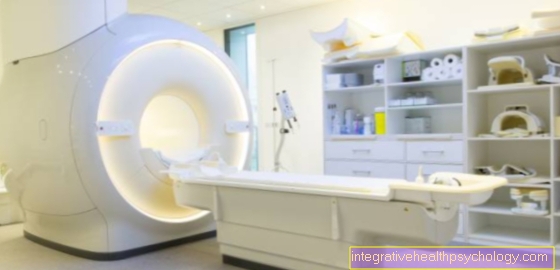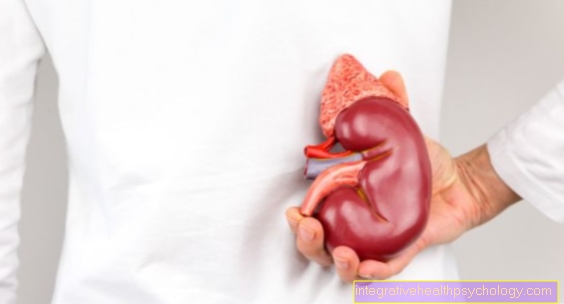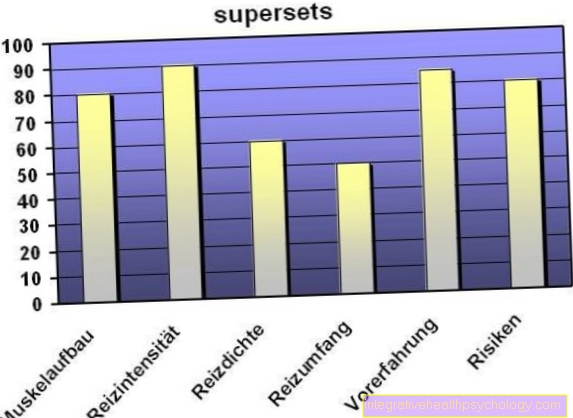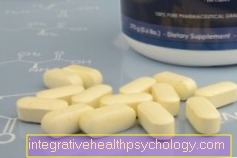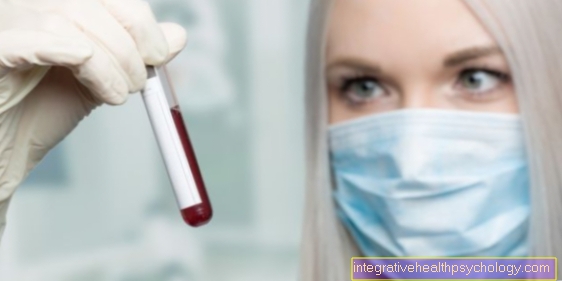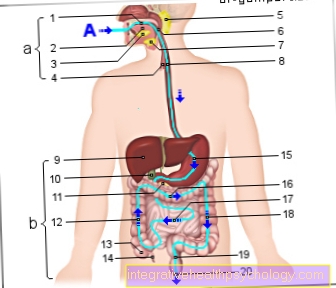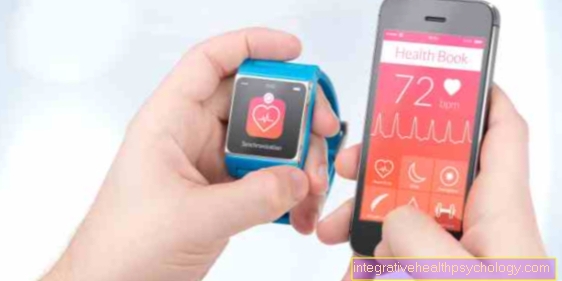shock
definition
Shock is an acute circulatory failure due to a critical reduction in the volume of blood circulating in the vascular system. More precisely, the term shock describes a disproportion between the vascular capacity required to keep all organs efficient and the filling of the vessels due to various causes.
Heavy bleeding, but also sudden widening of the vessels, can be the cause of shock.
The resulting reduced blood supply to the organs can damage the organs or even lead to organ failure.
Especially tissues that depend on good blood circulation, such as:
- brain
- Kidneys
- heart
and - lung
run the risk of serious damage in a shocked state.
To avoid this, the blood centralizes itself in shock, which means that the body “collects” the blood to ensure the blood flow to the vital internal organs in the trunk of the body. This also explains the pale skin color of the patient in shock.
Depending on the cause, a distinction is made between:
- Volume depletion shock (hypovolemic) shock
- the cardiogenic (heart triggered) shock
- the allergic (anaphylactic) shock
- the septic shock
and - the neurogenic (from the nervous system) shock.

General
The term shock describes a life-threatening condition of the body in which the blood circulation in the smallest vessels is reduced.
This leads to an insufficient supply of oxygen to all tissues and ultimately to metabolic disorders.
There are different forms of shock depending on the underlying cause. All types of shock have some key symptoms in common.
This includes a massive drop in blood pressure, which leads to the release of catecholamines (adrenaline, noradrenaline).
These cause an increase in the heart rate and constriction of the arterioles and venous capacity vessels. This regulation means that blood pressure can initially remain stable. The amount of blood is redistributed in the most important organs (centralization). This includes the blood flow to the
- Brain and des
- Heart.
At the beginning of the shock, the influx of fluid from the tissue (interstitial fluid) increases in order to compensate for the lack of volume. However, with increasing oxygen deficiency in the tissues, the amount of acidic metabolites (e.g. lactate) increases, causing the fluid in the vessels to decrease.
This increases the volume deficiency and the blood pressure continues to drop. In addition, the accumulation of acidic metabolites causes the small arterial blood vessels to relax. However, the small veins do not slacken, which leads to blood congestion in the small arterial vessels.
This leads to the formation of small clots called microthrombi. Ultimately, these can obstruct the blood supply routes to the individual organs and lead to blood clotting (Disseminated intravascular coagulation) to lead. This can be the cause of multiple organ failure and is fatal in most cases.
The shock regulation affects all other organs.
- The kidney gives up its function and the urine remains through the
- Reduced blood flow to the heart muscle increasingly leads to heart failure.
- Small emboli form in the lungs,
- pulmonary edema can develop and ultimately respiratory failure occurs. This is associated with a very high mortality rate.
The hypovolemic shock
Of the hypovolemic shock is associated with a decrease in the amount of blood circulating. A volume deficiency of up to 20% (approx. 1 liter) is usually well compensated by the body. Can cause the great lack of volume
- blood- and Plasma losses for example through organ injuries or
- Pelvic fractures with tearing of the great vessels,
- massive Vomit or diarrhea
- or severe dehydration (Dehydration)
While in Stage 1 of the hypovolemic shock the blood pressure remains largely stable, it falls in Stage 2 systolic to below 100mm Hg, the Pulse increases to> 100 / min and it comes to strong Feeling thirsty and a lack of urine production as a sign of Volume deficiency.
in the Stage 3 if the blood pressure falls below 60 mm Hg, the pulse is hardly present and the breathing becomes quick and flat.
Usually the symptoms go along with it Impaired consciousness hand in hand.
Cardiogenic shock
In contrast to this is the cardiogenic shockwhich one Pump failure of Heart underlying. This can have various reasons, for example
- a Heart attack,
- Inflammation of the heart muscle,
- Damper malfunctions or the
- Pulmonary embolism.
The cardiogenic shock is a systolic Drop in blood pressure <80mm Hg, one Heart index <1.8 l / min / m2 (cardiac output related to the body surface area) and an end-diastolic pressure diagnosed in the left heart> 20mm Hg.
The anaphylactic & septic shock

The third large group of causes of shock is the failure of peripheral circulatory regulation by the anaphylactic or septic shock.
The anaphylactic shock occurs when massive allergic Reactions on, triggered for example by a Wasp sting.
It comes to
- Drop in blood pressure,
- Increase in heart rate and can go up to
- breath- and Cardiac arrest to lead.
Of the septic shock however, arises from a massive inflammationthat spreads through the blood and so on Blood poisoning leads. If the inflammation persists too long, it can spread throughout the body and lead to a generalized inflammatory response in the body. The patients mostly suffer
- under Temperatures > 38 ° C or <36 ° C,
- the Heart rate increases> 90 beats / min,
- the Respiratory rate increases> 20 / min and the
- Laboratory values show markers of inflammation, such as an elevated one CRP and a Leukocytosis (increased White blood cells in blood).
There is also an underlying disease such as a Organ perforation (Perforation of organs), a large one injury or one infection with highly pathological bacteria.
therapy
The symptomatic therapy of shock is the same regardless of the cause. Here is the Monitoring of blood pressure, pulse, breathing, urine output and blood count in the foreground. In addition, the patients with oxygen through a nasogastric tube supplied and the Keep airways clear.
The causal therapy differs depending on the cause.
- Of the hypovolemic shock is mainly through adequate volume treated. This is the only way to save the patient's life. Be initial 500-1000 ml of a plasma expander given intravenously. Plasma expanders are colloidal plasma substitutes with a higher oncotic pressure than the body's own plasma. This leads to a maximum liquid inflow in the Vessels and thus has one Volume effect of> 100%. The further volume compensation takes place with isotonic saline solutionsto compensate for the cellular fluid deficit.
If major blood losses are the cause of the hypovolemic shock, they are prevented by the Giving blood transfusions balanced. Of course, this must address the origin of the blood loss, i.e. the bleeding vessel closed, or the treating causal injuries become. - Of the cardiogenic shock becomes symptomatic by Upper body elevation and Morphine administration Treated to relieve the pain of an oxygen depletion Heart muscle to treat. The cardiogenic shock is treated causally depending on the specific cause. Is a Heart attack The reason for the shock must be Heart vessels reopened and be supplied with blood. At Damper malfunctions these are supplied surgically. Inflammation of the heart muscle have to go through Administration of antibiotics and bed rest are treated. The Pulmonary embolism by dissolving the blood clot with drugs or surgery.
- Of the anaphylactic shock must be quick medicinal treated in order to stop or counter-regulate the body's own reactions to the allergen. Patients will be with sufficient Fluid through the vein provided (2000 - 3000ml in 30min). In addition, the patient Histamine antagonists administered. These inhibit the body's own histamine, which is responsible for the allergic reaction. For circulatory stabilization, vasoconstriction and possibly for resuscitation, the patient adrenaline injected. It comes to massive narrowing of the bronchi due to the allergic reaction, it becomes a fast-acting bronchodilator drug inhalatively or intravenously administered. If the airways swell, the patient must be intubated and ventilated early. Regardless of the extent of the anaphylactic reaction, all patients will Inpatient monitoring for at least 24 hours.
- Of the septic shock must be treated primarily by treating the underlying disease. This means that the entry gate / the focus of the infection must be found and repaired. In addition, the patients are with Broad spectrum antibiotics treated and one goal-oriented cardiovascular therapy Is initiated. If necessary, this includes Volume and oxygen administration. To prevent a possible generalized coagulation, prophylactically a small dose can be used Heparin administered. The basic rule is that patients must be monitored in the hospital for a longer period of time in order to avoid a possible re-emerging infection with signs of sepsis. A continuous monitoring of heart rate, blood pressure, temperature and breathing. In addition, the general condition of the patient is an important parameter for monitoring the success of the therapy.





